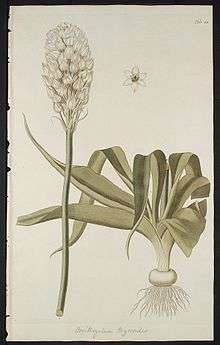Ornithogalum thyrsoides
Ornithogalum thyrsoides[2] is a bulbous plant species that is endemic to the Cape Province in South Africa. It is also known by the common names of chinkerinchee or chincherinchee, star-of-Bethlehem or wonder-flower.[3] It produces long-lasting flowers prized as cut flowers.[4]
| Ornithogalum thyrsoides | |
|---|---|
 | |
| Scientific classification | |
| Kingdom: | Plantae |
| Clade: | Tracheophytes |
| Clade: | Angiosperms |
| Clade: | Monocots |
| Order: | Asparagales |
| Family: | Asparagaceae |
| Subfamily: | Scilloideae |
| Tribe: | Ornithogaleae |
| Genus: | Ornithogalum |
| Species: | O. thyrsoides |
| Binomial name | |
| Ornithogalum thyrsoides | |
| Synonyms[1] | |
|
List
| |
Description
It is perennial, attaining 29–50 cm (11–20 in) in height, becoming dormant during winter. It produces half-a-dozen fleshy leaves which die after flowering - the leaves being some 15–30 cm (5.9–11.8 in) in length and 0.5 to 1.5 cm in width, lanceolate, smooth and soft-textured. The flowers are in a compact raceme of 30-50 or in a loose corymb of 5-20 flowers. The flowers are bowl-shaped with green bracts of approximate pedicel length. Flowers are white to creamy-white, with brown or green centres fading with age. They are seen from October to February, and are phototropic (turning towards the sun). The spindle-shaped capsular fruit holds black, shiny seeds of diverse shapes.
History and names
The plant was first named under the Linnaean System by the Dutch-born botanist Nikolaus Joseph von Jacquin in 1776, shortly after the plant was introduced into Dutch gardens.[4] It has been cultivated in temperate Europe ever since.
The Latin specific epithet thyrsoides refers to a specific type of inflorescence, the thyrse - and ultimately to a type of ancient Greek staff or wand, the thyrsus.[5]
The common name chincherinchee is a translation of the Afrikaans name for this species, tjienkerientjee, which refers to the sound made by stalks rubbed together,[4]
Cultivation
O. thyrsoides has received the Royal Horticultural Society’s Award of Garden Merit.[6][7] It is grown in a sunny or partially shaded sheltered spot. The plant becomes dormant shortly after flowering in spring and early summer. The dormant bulb must not be exposed to freezing temperatures.
References
- "The Plant List: A Working List of All Plant Species". Retrieved March 10, 2014.
- Thyrsoides: with a flowering spike like a Bacchic thyrsus.
- "Ornithogalum thyrsoides". Germplasm Resources Information Network (GRIN). Agricultural Research Service (ARS), United States Department of Agriculture (USDA). Retrieved May 6, 2008.
- "Ornithogalum thyrsoides". PlantZAfrica.com. South African National Biodiversity Institute. Retrieved 15 September 2019.
- Harrison, Lorraine (2012). RHS Latin for Gardeners. United Kingdom: Mitchell Beazley. ISBN 184533731X.
- "RHS Plantfinder - Ornithogalum thyrsoides". Retrieved 14 April 2018.
- "AGM Plants - Ornamental" (PDF). Royal Horticultural Society. July 2017. p. 64. Retrieved 14 April 2018.
![]()
_(6931332103).jpg)
